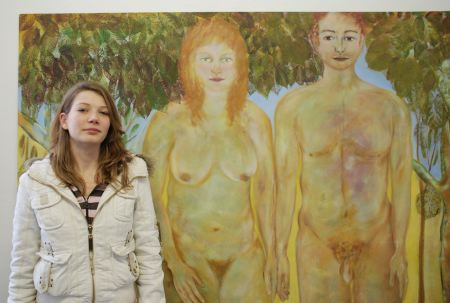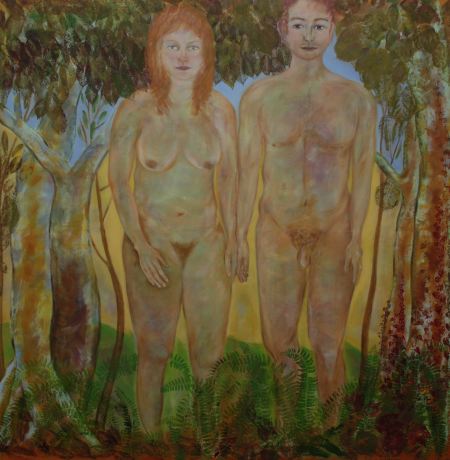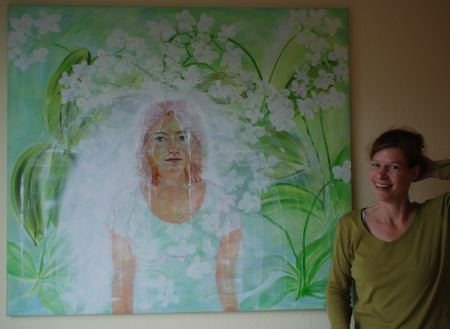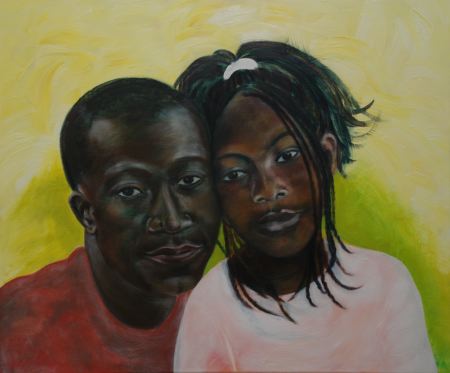
Carina Fernhout painted this larger-than-life meta self-portrait as Eve; to the right is Adam, to the left, her daughter.
KARL: Who does the Adam figure represent in your painting?
CARINA: Yes, what a difficult question! Maybe all the men I know, or all the men I want to know.
KARL: The Adam is really a meta-portrait of men?
CARINA: Yes, whatever that means.
KARL: Why are the figures so big?
CARINA: It wasn’t at first the intention, but when they are so large I can “feel” them while painting, almost like sculpting them; the canvas felt as though it were their skin. I just wanted them to be life sized, but they came out even bigger.

KARL: When you have a large painting like this, how does it interact with the environment where it is?
CARINA: Well, it takes up a lot of space, as a painting. It influences me, certainly. It took me three months to paint. When I make something big, I move a lot more, walk back and forth from the painting, and have a lot more exercise. I love to paint with a BIG BRUSH. It’s not always practical, but large is what I find the satisfying.
KARL: What is the effect of such a big painting to look at, once it is made?
CARINA: You can feel as if you are in the same landscape as the people on the canvas. When I see people in front of the painting, it as if they enter that world.
KARL: Here [below] you are with another self-portrait.

CARINA: At first I was inspired by the color white. I wanted to paint a woman like an Islamic woman with a white headscarf, but in the end it looked more like a bride in the Western tradition. I made a self-portrait because I was a little sad and a little serious. What I found nice to paint were these orchids behind her and running through her.
KARL: It is a very soft picture, and yet there is an intense gaze of you looking out.
CARINA: I don’t know why it is like that, but it says a lot about her feelings.
KARL: Is this painting about a longing you have to be a bride, or is it closer to the self-wedding of Jennifer Hoes?
CARINA: It has to do with a promise to myself.
KARL: What is the promise?
CARINA: To be honest to myself.
KARL: Is Jennifer Hoes causing all the women of Haarlem to marry themselves?
CARINA: [Laughs] I knew about her wedding. I’m sure it influenced me in an unconscious way. That is the good thing about Haarlem, there is a lot of inspiration in the air.
KARL: Please tell me about this double portrait.
CARINA: This is a portrait commission, also larger than life, of my neighbor and his daughter who are originally from West Africa. I chose to paint the portrait so large, and with thin layers, transparent, because it fascinated me so much — making it larger than life made it more real.

KARL: I see an intensity of gaze again in this picture, but the feeling is very different from the wedding self-portrait above.
CARINA: There is not a clear line between the father and daughter, they are so close together, there is an intimacy, whereas the self-portrait has a feeling of isolation. In the big Adam and Eve picture, these is intimacy in the way Adam’s arm is against Eve’s, but that is the only indication of intimacy or affection that you see. I felt that Adam and Eve should stand apart because there is a lot that they don’t understand about one another. With the father, a single parent, and daughter it is different, there is a much stronger bond.
KARL: How does this compare to your bond with your daughter?
CARINA: People often ask if the wedding self-portrait is of my daughter. I think that I identify very closely with my her, and she with me. But she is at an age where she doesn’t like that, where she wants to break free.

You know, seeing some nice big oil paintings like these was like fresh air to me on Art and Perception. I think it is really nice use of color on the large canvas. I liked the commissioned portrait the best, but the others are also just as super. Your delivery of an individuals gaze is perhaps a commendable aspect of your work. In fact in your second self portrait, you arrest the person with the gaze and then soothe the strong emotion there with the translucent orchids running all over the canvas. Very good!!
I paint on canvases that are about four feel tall by three feet wide and ‘sort of’ identify with large portraits and had a couple of questions for you…
1. How do you manage to layout the preliminary sketches for proportions and overall unity of the figure?
2. How do you get people to pose? Do you photograph first and then work off that or do you ask them to sit for the preliminary layout?
3. What size brushes do you use? Do you employ any oil paint conservation techniques (make it go the extra mile)?
4. Where do you paint? I must imagine in an outhouse or something like that with a canvas size that big…
Hopefully I have not inundated you with too much, but a small discussion around some of this would be very instructive…
Carina,
I like it that you are working large, in part perhaps because I try to work large, also. You are quite right that “When I see people in front of the painting, it as if they enter that world.” This is true for most effective large works and is one of the reasons I like the larger than life size. The thin layers on the commissioned picture works beautifully with the lush skin tones, too.
Adam’s eyes startled me. He is refusing to look at the viewers, whereas all the others look at the viewer with direct and sometimes piercing gazes. The direct gazes are of different intensities and seem to have diffent meanings to me, but Adam seems to be evasive or elsewhere in a way the others aren’t. Do you suppose that’s because you are painting what we used to call The Other? By The Other, I mean the object or type off which we tend to define ourselves, or the kind of human who is mysteriously not like us?
Interesting point about Adam’s eyes. I actually find it more engaging, at least in combination with Eve; I try to follow his gaze and wonder if he is looking towards Eve, towards something not shown (a cat or dog?!), or outside the painting (the daughter, my cat?).
[Translated by Karl]
Sunil,
I don’t make preliminary drawings on a small scale. I just begin with painting. I start painting the big forms — head, arms — but not details like eyes and nose. I start painting with a large brush, say 5 cm broad.
The portrait commission is from a photo, the other portraits are done in a mirror.
As a painting medium I use liquin (Windsor & Newton), sometime a little bit of linseed oil, and also turpentine. These makes the paint a bit more fluid. The liquin is useful for glazing.
I paint in my studio. One wall is 4 meters high, so I have lots of space for the large canvases.
June,
It is true, Adam has a very different gaze. Why? That is a very interesting question. I was also surprised at how he came out. I think that he is more of the dreamy kind of person, that is why he more looks inside. Eve is more awake, he his not quite awake or aware.
Steve and June,
The impact of this the Adam and Eve painting is hard to convey in a small image. When I first saw this couple I was shocked. The frank, open gaze of Eve, combined with the nudity, emphasized by contrast with Adam’s different gaze (however we interpret his expression), all at this greater than life scale is simply breathtaking.
I like the 2nd portrait with the white orchids and green background. It’s comforting to look at.
Carina first work resembles primitive style and the Adam and Eve theme emphasis that so really works well together.
I would like to see more…
Great paintings, and I agree with Sunil that the large scale is refreshing.
I see Adam’s gaze as a bit shady, like he is up to something!
But what I find most unsettling in that piece is that bright yellow peeking from behind the figures and the greenish tones in their bodies. THe color schemes are surprising adn unique.
To me the paintings not done form photos are more “alive” than the photo portrait. I love the intense look of the father child, but I miss the inventiveness with paint and color of the other ones.
Thanks for sharing your art!
I also find Adam more dreamy or child-like.
Wouldn’t an artist doing a self-portrait look at herself critically, evaluating how the painting looks? But Eve looks a little down on me and in bride looks a little to the left of me.
I love the intertwining and dancing trees next to Eve.
Carina’s first work resembles primitive style and the Adam and Eve theme emphasis that so really works well together.
Angela,
I think you are on to something important here. I was mentally grasping for these words earlier, but I didn’t reach them. Let me talk again about my experience in front of the real painting, that first moment. Part of the shock was that, yes, despite the “primitive style,” the feeling of connection with the Eve figure staring out at me was profound. The style I think had the effect of putting her at a distance, while the gaze and size brought her very close. This tension was part of the power I think.
Leslie,
Adam does seem a bit shady, but perhaps that is the context in the first photo. That is, it might be an art about art issue. On Carina’s website there is a detail of this face alone, in quite a different context. There my interpretation of his gaze is quite different.
Birgit,
Here you have hit on another interesting thing I didn’t notice: artists making self-portraits in the mirror often have this strained “can I paint myself?” look. The Eve self portrait has an entirely different quality. It is more of a meta self-portrait, a psychological self-portrait of the artist I think, than a physical likeness.
Carina,
Curious.
I like how Eve’s right hand is placed over her thigh, in-between temptation and shame (though the shadow there creates a strange gap). I am also struck by how her left hand-arm seems unmoved by the nudge-push from Adam’s right arm, while his left arm remains limp. Both seem more determined to maintain their pose than commit an act.
Their forward position (cropped near or at the head, his brain) adds to my sense of their awkwardness.
Personally, not being a religious guy, I have always appreciated A&E more for their physicality. I suppose that is why I am a bit baffled by their transparency and general lack of roundness. Skin! If they are to touch, where is the satisfaction of weight?
And as for their gazes, I am struck by their general indifference to one another. They seem more interested in me or what is behind me. I wish I wasn’t distracting them.
I appreciate the off-center composition and especially how it allows your daughter to pose, within. With the slightest gesture, a turn of a raised chin, she reveals her Position.
I see Adam and Eve bonding through their right and left arms, respectively. Adam’s left ribcage looks a little reddish, leftover from surgery? Didn’t he loose a rib from which Eve was made?
Joking aside, I think that the picture is powerful: Adam and Eve bonded via their arms with the intertwined trees on the left further emphasizing the bonding.
Eve looks at the reality why Adam absent, thinking of something.
To be psychological, one could say that the female in the artist is the practical, ready to deal with any challenge, while the male in the artist is the dreamer.
The yellow behind them is the rising sun, symbolizing their energy.
I think that the ferns in the foreground have a special meaning for the artist.
The transparency mentioned by D. could be intended to convey the symbolic meaning of this picture, not really Adam and Eve but the different characters within the artist herself.
Birgit,
The ferns are painted by using real ferns to transfer paint to the canvas. This is an advantage of painting on a more or less life-sized canvas.
Thank you, Carina for answering my questions and Karl for translating the same…